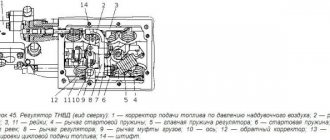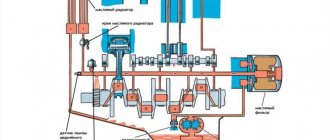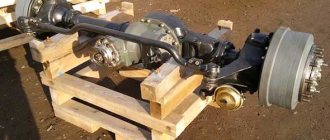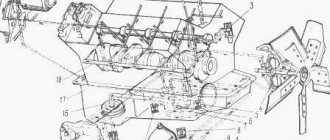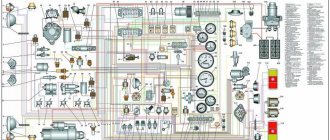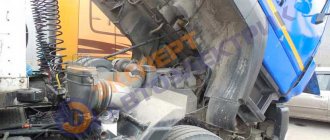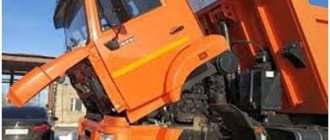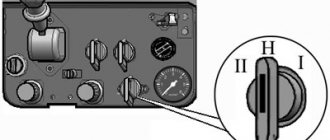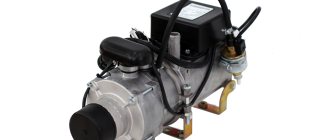A distinctive feature of a diesel engine from many gasoline analogues is the absence of an ignition system, since the mixture of fuel and air in the diesel cylinders ignites independently (from strong compression and heating). In this case, it becomes necessary to supply fuel to the combustion chamber under high pressure.
There are several types of diesel engine power systems, which differ in design and implementation, but the common thing is that each fuel system pumps fuel for subsequent injection of diesel fuel through diesel injectors.
It is quite obvious that for diesel engines, maximum tightness of the entire fuel system is extremely important. If air gets in, then the required injection pressure cannot be achieved. Moreover, excess air can damage expensive elements of the fuel supply system. Next, we will look at why and how to de-air the fuel system of a diesel engine.
How to bleed the fuel system on a Kamaz with a Cummins engine
Cummins lnc. is one of the most famous manufacturers of diesel internal combustion engines. The corporation produces durable, reliable, enviable power and environmentally friendly engines.
Cummins engines are distinguished by their most complex and advanced fuel supply system. The main feature of fuel systems of this brand is that diesel fuel is sprayed into the engine cylinder under very high pressure, which allows to reduce fuel consumption and at the same time increase power.
How to bleed the fuel system of a KAMAZ Euro 3 diesel engine
Injection pump pumping 100% RESULT
how to bleed air on a diesel engine
1. (Kamaz 740) Diesel power system
Air leak
pumping the fuel system diesel R170-R195 walk-behind tractor and motor-tractor
KAMAZ fuel coarse filter with heating.
Bleeding the injection pump
Diesel engine fuel system
2013 How to pump fuel into the fuel filter and bleed the system.
Kamaz troit stalls
Also see:
- Vacuum machine KO 529 13 on KAMAZ 43253 chassis
- KAMAZ ball joint repair kit
- Vin of KAMAZ trucks
- How to install an air seat on a KAMAZ
- Inf on the KAMAZ device
- New KAMAZ autopilot
- Fuel adjustment screw KAMAZ
- KAMAZ engine smokes after capitalization
- Electrical circuit of the KAMAZ brake
- Axle shaft seal KAMAZ 43118 size
- Wiring diagram KAMAZ 5320
- KAMAZ engine switch
- GTA video on KAMAZ trucks in the mud
- Types of firefighting KAMAZ trucks
- Hair dryer for KAMAZ device
Home » Popular » How to bleed the fuel system of a KAMAZ Euro 3 diesel engine
kamaz136.ru
Bleed the fuel on the Cummins ⇐ ERF. Engine
Moderator: diagnostMAN
Topic author
AlexTula Newbie Messages in topic: 3 Total messages: 5 Registered: 03/21/2012 Car: ERF tractor 2003 analogue MAN engine Cummins From: Tula Russia Age: 47
Pump the fuel on a Cummins
Post by AlexTula » 02 Apr 2012, 16:07
And again I'm with my hemorrhoids
Our pepelats with the 14th Cummins stalled. Diagnostics showed that the electronics are in order, there is no fuel. They removed the boost pump - it seemed to have died.
They installed it from a working car.
So it still won’t start, and the line from the tank to the pump was filled with fuel and towed - to no avail.
Here are the questions
How to check that the pump is pumping?
How to bleed the line to the injectors?
AlexTula
diagnostMAN Moderator Messages in topic: 3 Total messages: 449 Registered: 02/09/2012 Car: MAN From: Moscow
Re: Bleed the fuel on a Cummins Post by diagnostMAN » Apr 03, 2012, 08:26 pm
AlexTula: How to check that the pump is pumping?
If you check the booster pump, then remove the tube to the fuel injection pump and turn it with the starter, it should flow briskly. Ideally, hang a pressure gauge on the tube and it should be about 5-6 bar.
Checking the fuel injection pump is about the same; if you have a common rail system, it’s better to check it with diagnostic equipment. pressure at idle in the rail is 500 bar!!! If it is an in-line pump, then check it as well as the booster pump.
AlexTula: How to bleed the line to the injectors?
there is no need to pump the line to the injectors; if the injection pump pumps, then 7 seconds of starter operation is enough for all the air to fly out through the injectors
If the advice helped or did not help, please unsubscribe for people who have a similar problem, I will disable adBlue on mana
diagnoseMAN
diagnostMAN Moderator Messages in topic: 3 Total messages: 449 Registered: 02/09/2012 Car: MAN From: Moscow
Re: Bleed the fuel on a Cummins Post by diagnostMAN » Apr 04, 2012, 09:31 pm
diagnostMAN: there is no need to bleed the line to the injectors
I’ll make an amendment in your case, the engine most likely has pump injectors, as in this option, check the fuel, I don’t have any information, try to find out in the section of American trucks Kamens from them
If the advice helped or did not help, please unsubscribe for people who have a similar problem, I will disable adBlue on mana
diagnoseMAN
autoin Ignition Messages in topic: 3 Total messages: 13 Registered: 04/17/2012 Car: MAN ERF 2002 From: Noginsk Age: 55 Re: Bleed the fuel on a Cummins Post by autoin » Apr 19, 2012, 10:56 pm
AlexTula: Our pepelats with the 14th Cummins have stalled.
How did the story end?
I had a similar problem on 11th. I just turned off the engine myself.
The car would not start until you moved the wiring harness that goes to the pump injectors under the valve cover. After starting the engine, there was no reaction to the movement of the harness - everything worked. In the place where the harness was attached, they found a bare wire, which may have rubbed against the clamp. They insulated it and it started to start. Unfortunately, it was not possible to find out what kind of wire it was.
So, what did you have?
Do not forget:
If the advice helped or didn’t help, sign up for
people who have a similar problem.
autoin
diagnostMAN Moderator Messages in topic: 3 Total messages: 449 Registered: 02/09/2012 Car: MAN From: Moscow
Re: Bleed the fuel on a Cummins Post by diagnostMAN » April 20, 2012, 10:02
autoin:Don’t forget: If the advice helped or didn’t help, post it for people who have a similar problem.
this is my call and I would also listen to the answer from AlexTula
If the advice helped or did not help, please unsubscribe for people who have a similar problem, I will disable adBlue on mana
diagnoseMAN
Topic author
AlexTula Newbie Messages in topic: 3 Total messages: 5 Registered: 03/21/2012 Car: ERF tractor 2003 analogue MAN engine Cummins From: Tula Russia Age: 47
Re: Bleed the fuel on a Cummins
Post by AlexTula » April 23, 2012, 09:13
Hi all!
I apologize for the silence.
It wasn't the bobbin
, i.e. not in the pump.
The pump is driven by the compressor. When we were dragging the car to the base in gear, we noticed that the air was pumping no more than 6 atm. We removed the compressor - diagnosis - the compressor drive clutch was worn out, replaced it, key to start - and there it was, the powerful growl of the Cummins.
But the problems are not over
. It started to fluctuate, as if the injectors were playing tricks.
Brothers, tell me where I can adjust/check the pump injectors and find out the valve clearances. Preferably closer to Tula, otherwise no one is doing this in our village
AlexTula
autoin Ignition Messages in topic: 3 Total messages: 13 Registered: 04/17/2012 Car: MAN ERF 2002 From: Noginsk Age: 55 Re: Bleed the fuel on a Cummins Post by autoin » Apr 23, 2012, 09:33
AlexTula:But the problems are not over
Good afternoon
I’m not familiar with the drive mechanism for the boost pump on the 14th, but on the 11th it is attached to the compressor and driven through a clutch. It is plastic, if there is wear, the pump may not create the necessary pressure. Check, just in case, the booster pump drive clutch. And necessarily the pressure created by the pump.
You can do all this yourself, without the participation of a service. Accordingly, the possibility of “divorces” and repairs through the gradual replacement of everything in order will be reduced.
autoin
Topic author
AlexTula Newbie Messages in topic: 3 Total messages: 5 Registered: 03/21/2012 Car: ERF tractor 2003 analogue MAN engine Cummins From: Tula Russia Age: 47
Re: Bleed the fuel on a Cummins
Post by AlexTula » April 24, 2012, 10:24 am
The coupling is steel, but there was a problem with it - the splines were worn out. I now need to adjust the pump injectors, is there such an address?
AlexTula
- 2 Replies 434 Views Last post kolya.kovtalyuk May 16, 2022, 10:35 am
- cummins pan 15 Answers: 2 First message Hello guys. A crack appeared in the pan near the drain plug. We welded it with a ballet, it doesn’t leak. Will he walk? Who has experience? Many people say that it will crack near the weld. Engine cummins 15
Last messagegreat guys no lights in the cabin nothing changed the fuse still the same
2 Replies 1770 Views Last post Guest 09 Sep 2016, 14:08
- cummins pan 15 Answers: 2 First message Pallet cummins 15 Hello guys. A crack appeared in the pan near the drain plug. We welded it with a ballet, it doesn’t leak. Will he walk? Who has experience? Many people say that it will crack near the weld. Engine cummins 15
Last message
I already have the fourth one, I don’t know what to do, I’ll change the front cushion under the engine, I have a Volvo VNL 670, and it also bursts near the drain plug on the left side as the car moves. A friend of mine also burst, changed the pillow and the problem disappeared.
2 Replies 2062 Views Last post Deflector 05 Jan 2021, 11:21
- Cummins 14 takes a long time to start. Answers: 1 First message Guys, help the Cummins 14 takes a long time to start. What to do?
Last message
Look where there is air, but haven’t you done anything to the engine?
1 Replies 5685 Views Last post by Vasek on Mazik 02 Jul 2014, 10:13
- Freightliner CUMMINS N14 Plus – electrical Answers: 2 First message Tell me... What kind of fuse is on the engine control unit? Does it come out of the top far connector and sit on the body (i.e. minus)? What is he responsible for?
Last message
OK. THX
2 Replies 4887 Views Last post by BUDU200 Dec 26, 2014, 4:20 pm
Best answers
Rudy:
There is a hand pump and pump it. you don’t let the air out anywhere, the fuel drains back into the tank, but still, when starting, even if you pump it up, you won’t be able to start it with half a shot because there will also be air in the pipes to the injectors and you will have to use the starter
toha:
Bleed the air from the return and turn it around.
Unknown:
On the side of the fuel filter housing there is a wrench fitting for 12, unscrew it a little and pump it with a booster pump until the diesel fuel comes out clean without air bubbles, tighten it and start the engine
When is fuel volume adjustment necessary?
In general, the following signs indicate problems with the operation of the high-pressure pump and the need to reduce or add fuel:
- Changes in engine power and its operation intermittently. Usually the reason here lies usually with the injection of fuel portions of different volumes, which requires adjustment of the fuel injection pump or, in advanced cases, repair of the latter.
- Reduced engine power. The reason lies in the untimely entry of fuel into the combustion chamber, which leads to delayed ignition, incomplete combustion, and this negatively affects efficiency. The solution will be to adjust the injection pump, namely how to add or reduce fuel. In advanced cases, repairs and replacement of main components may be necessary.
- Fuel leaks or increased consumption. The problem is usually associated with wear of individual components of the fuel injection pump or engine due to low-quality fuel. Problems can be minimized at the initial stage, but in the future repairs or even replacement of the injection pump and its key components will be required.
- Extraneous noise when starting the engine and its subsequent operation. Here the reason may be either incorrect adjustment of the fuel injection pump, or its wear, engine malfunctions, or fuel system.
Correct operation of your KAMAZ truck plays an important role in the service life of the pump. To prevent problems and reduce unnecessary transport downtime, follow the following rules:
- for refueling, use only high-quality fuel from proven gas stations;
- Replace fuel filters regularly;
- carry out preventive monitoring after 4000-6000 hours of operation;
- periodically drain the water from the fuel filter sump;
- If there are problems in operation, carry out diagnostics and repairs in a timely manner.
At the same time, you should not count on the magical properties of numerous additives, which, if the quality is insufficient, can lead to the opposite effect, “masking” the problems.
Let's sum it up
As you can see, the main method of bleeding a diesel fuel supply system is a labor-intensive procedure that requires certain skills. It is important to maintain cleanliness and prevent dirt, dust or debris from entering the pump.
As for pumping through the “return” using a compressor or the method described above with pumping with a vacuum cleaner, the effectiveness of such methods in some cases may be low or even questioned. For this reason, it is strongly recommended to bleed the diesel engine power system at a specialized car repair and maintenance center.
Finally, I would like to note that if the power system is regularly aired out, and the reason is difficult to determine, a solution to the situation may be to install an additional fuel priming pump on the injection pump.
Why is a low-pressure booster pump needed in the diesel engine power supply system? Operating principle and design of low pressure pumps, types of pumps, features.
Airing of the diesel fuel system: signs of malfunction and diagnostics. How to find the location of the air leak yourself, ways to solve the problem.
Design of a high-pressure diesel fuel pump, potential malfunctions, diagram and principle of operation using the example of a fuel supply system.
What fuel injection systems are installed on diesel internal combustion engines. Diagram with mechanical injection pump, pump injector, Common Rail. Device, pros and cons.
Purpose of the high pressure fuel pump in the fuel injection system of a diesel engine. Types of injection pumps, design features of pumps.
Common diesel engine malfunctions and diagnostics of units of this type. Checking the fuel system of a diesel engine, useful tips.
How to easily pump oil on a KAMAZ)
Injection pump Bosch Kamaz Euro 2
replacing BOSCH fuel injection pump with KAMAZ fuel injection pump! ALL KAMAZ vehicles are equally different! Kamens motor assembly
Differences between Kamaz BOSCH injection pump
Launching KAMAZ, Problems with fuel injection pump, (Part 1)
Injection pump pumping 100% RESULT
Injection pump Bosch Kamaz Euro 2 325 hp — 0402736931, (0 402 736 931), 3974514
The pump has stopped working
We found the reason why KAMAZ does not start on Common Rail BOSCH
how to bleed air on a diesel engine
Cummins fuel system design
The Cummins fuel system consists of several main elements: a fuel line, or ramp, an injection pump, a control module with a sensor system, a fuel filter, injectors, and a fuel tank.
In order to reduce the length of the fuel rail, the injection pump is located as close as possible to the injectors. Fuel injection pumps include:
- frame;
- discharge valves;
- all-mode regulator;
- covers;
- injection advance clutch;
- pushers;
- booster pump;
- plunger return springs;
- fittings;
- plunger sleeves;
- lath;
- camshaft;
- plungers.
A filter is placed between the fuel tank and the injection pump, which simultaneously performs the function of a manual pump. The filter includes a water sump, a booster pump and a replaceable filter element.
On the first type of nozzles, the pressure is adjusted using a screw. The second type is nozzles in which the pressure is regulated by washers. The Common Rail system uses a third type of injectors with electronic pressure control. The injectors can be equipped with either a piezoelectric or solenoid valve.
The Cummins engine belt for a GAZelle car is a flexible ring, which has a unifying function. Its force drives the camshaft and crankshaft.
Any repair of the Cummins isf 2 8 crankshaft, as well as other types of shafts, is completed by thoroughly washing the product and blowing it with compressed air until the shaft is completely dry, read the details here.
Despite all the variety of these parts, the principle of their operation remains the same. Fuel is supplied to the injectors under high pressure and then sprayed directly into the cylinders.
A characteristic feature of Cummins fuel injectors is the presence of solenoid valves that allow metering of the supplied fuel. The same function is performed by a control unit built into the engine. Excess fuel is returned to the fuel tank via the return line.
Why is there a need to bleed the fuel system of a diesel engine and how to do it
As mentioned above, diesel fuel is supplied under high pressure. The specified pressure is created by the injection pump (high pressure fuel pump). If air leaks occur, the pressure in the pump does not reach the required values for effective fuel injection into the cylinders of a diesel engine.
Naturally, in such a situation, the diesel engine does not start well, operation at idle and under load may be unstable (diesel throttles), the speed begins to fluctuate, the power unit may stall while driving, etc. Note that not only airing manifests itself in the form of these symptoms, but it may also well be one of the causes.
To solve the problem, you will first need to find out if there are problems with tightness. If this is the case, then you will need to remove air from the fuel system of the diesel engine. To determine whether air has actually entered the fuel system, the first step is to disconnect the high pressure fuel lines from the injectors. Then you should unscrew the nuts that secure the pipelines.
Next, you need to invite an assistant who will turn the engine with the starter. The main thing is to determine whether fuel is flowing or not flowing from the pipelines. If there is no supply, there may be air in the system and it needs bleeding.
- First of all, the fuel filter is pumped first. To do this, use a wrench to slightly unscrew the screw on the filter housing.
- Next, you need to pump fuel with a manual pump. Pumping continues until fuel begins to flow out through the screw hole, without air bubbles. The screw on the filter housing can now be tightened.
Note that not all diesel engines have a manual pump. On such engines, it will be somewhat more difficult to bleed the diesel fuel filter, since the fuel priming pump also does not work if the filter becomes airy.
To solve the problem, the screw on the filter housing is unscrewed, then an assistant turns the motor using the starter. Please note that the procedure may take a long time and there is a risk of completely draining the battery. For this reason, it is recommended to bleed the starter in a garage or use a booster (starter-charger) to minimize battery discharge.
How to bleed the injection pump
After the fuel filter has been pumped, you next need to begin removing air from the high pressure fuel pump.
- First you need to unscrew the central bolt, which is located centrally between the fittings of the high pressure lines;
- Next, the ignition is turned on, after which pumping is carried out using a manual booster pump. Pumping continues until fuel appears from the hole under the previously unscrewed central bolt.
- Now the bolt can be tightened a little to make it easier to control the presence or absence of air bubbles in the escaping fuel.
- If during the pumping process diesel fuel does not appear in the bolt hole, then you can crank the engine with the starter and continue pumping until clean fuel without air appears.
- After the air bubbles disappear, you need to unscrew the bolt again and start turning the engine from the starter. In this case, you should pay attention to how the diesel fuel is pushed out of the hole.
- Normally, fuel should come out with a pulsation and in doses. In this case, we can assume that the fuel injection pump is working properly, and problems with the operation of the motor arose due to airing in the system. The bolt can be tightened.
If fuel flows constantly, without interruptions, this may indicate that there is a problem with the fuel injection pump. In this case, a common cause is a broken plunger, plunger drive, etc.
In a situation where fuel does not appear in the hole, there is a high probability of failure of the booster pump, which is integrated into the injection pump. In both the first and second cases, the injection pump must be removed, after which the service will diagnose and repair the high-pressure pump.
- After bleeding the injection pump and tightening the bolt, you will need to loosen the fittings on the fuel lines and move each one to the side. Next, the assistant turns the engine with the starter until fuel begins to flow out through the fitting. If the diesel fuel does not flow out, you still need to unscrew the fitting with a spanner. Then the pumping is repeated.
After making sure that fuel has flowed through the unscrewed fitting, the specified fitting is tightened, after which similar actions are performed one by one with other fittings. A successful result can be considered when diesel fuel is supplied from all fittings while the starter rotates the crankshaft.
Now you can return the union nuts of the fuel lines to the injection pump fittings, after which they are tightened. The engine must continue to be turned with the starter, while the union nuts of the fuel lines are placed on the injectors in parallel.
In this case, the injector nuts are tightened only when fuel begins to flow out from under them. Previously, tightening cannot be done (for example, the nuts on the injectors are tightened first, and only after that on the pump fittings). In this case, you will need to pump air for quite a long time, during which time it is quite possible to discharge the battery.
Also note that the starter every 15 seconds. continuous work, it is recommended to give a break of about 60-120 seconds. Ignoring this recommendation may lead to damage to the starter or a significant reduction in its service life.
Engine | KamAZ 6520
The engine does not start There is no fuel Fill the fuel tank, bleed the power system The adjustment of the fuel injection advance angle is broken Adjust the fuel injection advance angle Presence of air in the fuel system Eliminate leaks, remove air. The water that got with the fuel into the fuel line or onto the fuel tank intake screen has frozen (in the cold season ) Carefully warm up the fuel filters, pipes, tank with a rag moistened with hot water or steam, do not use an open flame. The engine does not develop the required power. The air cleaner or air intake hood is clogged. Service the air cleaner or clean the hood mesh. The filter elements of the fine fuel filter are clogged. Replace the filter elements. Fuel is leaking from the system. Tighten the connections in the fuel line. The adjustment of the fuel injection advance angle is broken. Adjust the fuel injection advance angle. Poor fuel atomization by the injectors. Replace the injector nozzles. The adjustment of the speed regulator control drive is broken. Check and adjust the drive Thermal gaps have increased Adjust the gaps The fastening of the high-pressure tube is loose Tighten the fastening nut Fuel that is not appropriate for the season was used (the fuel has thickened) Replace the filter elements of the fine fuel filter, wash the coarse filter, replace the fuel with one appropriate for the season; bleed the power system Low pressure of charged air as a result of: - air leakage through the connections of the intake manifold with the cylinder heads, pipes, turbochargers and the compressor of the pneumatic drive of the brake systems; – tighten the connections, replace gaskets and connecting hoses if necessary; – gas breakthrough in the connections of the exhaust manifold and turbine housing; - tighten the connections, if necessary, replace the gaskets and connecting hoses; - seizing of the turbocharger rotor - if the rotor rotates tightly and touches the housing parts, replace the turbocharger; - contamination of the flow parts of the compressor or turbine - remove the turbocharger and remove deposits from the flow parts Extraneous noise in the turbocharger area Tighten the fastening parts of the turbine and compressor housings. Check that the rotor is not touching at its extreme axial positions; if the rotor is touching, replace the turbocharger. The engine knocks. Early fuel injection into the cylinders. Adjust the fuel injection advance angle. Thermal clearances have been increased. Adjust the gaps. Engine oil does not correspond to what is specified in the manual. Replace the oil. The coolant level in the expansion tank is below the permissible level. Find and eliminate leaks, restore normal coolant level Radiator shutters are closed Open the shutters The seal of the expansion tank plug is broken Replace the plug Low pressure in the lubrication system High oil temperature Make sure the pressure sensor and emergency oil temperature indicator are in working order. Open the oil cooler switch-on valve Dirty filter elements of the filter Replace the filter elements Low oil level Bring the oil level up to normal Leaks in the lubrication system Check the fastening of oil lines, oil filters, check for leaks in the oil cooler, fix the problem Clogged or stuck oil pump valves Wash the valves, replace broken springs Increased fluid temperature in the cooling system The fluid coupling switch is set to position 0 Move the switch lever to position A The fluid coupling switch is faulty Temporarily move the switch lever to position P; Adjust the switch as soon as possible. The drive belts are loose or torn. Tighten or replace the belts. The outer surface of the radiator core is dirty. Clean the radiator from dirt. Increased coolant consumption. Fluid leakage through the connections in the cooling system. Tighten the connections; if necessary, replace the gaskets and O-rings. Presence of engine oil in the coolant. Thermal power supply is loose. fluid coupling switch sensor Replace the valve with thermal power sensor
www.remkam.ru
Bosch KamAZ Euro-3 injection pump: design and adjustment
The German fuel injection pump for KamAZ Euro-3 is a common component of new models. However, Bosch pumps break down more often. The fact is that operating conditions for trucks in Russia are very different from German ones, so many owners replace Bosch fuel injection pumps with YAZDA (Yaroslavl plant). The latter are inferior in the accuracy of measuring portions of incoming fuel, but are better suited for use on local roads.
The design of the Bosch KamAZ Euro-3 fuel injection pump is not fundamentally different from Euro-2 or domestic fuel injection pumps.
For proper operation, regular diagnostics of the injection pump and adjustment are necessary, which is necessary in the following cases:
- Increased fuel consumption
- No fuel supply to the injector
- Noises in the pump
How the Cummins fuel system works
In a Cummins internal combustion engine, fuel is directed from the pump to the fuel line. Then, under high pressure, gradually accumulating in the fuel line, it is squeezed out into the injectors. The injectors are activated thanks to the ECM module, which regulates the injection timing.
Outside the engine there is a water separating fuel filter equipped with a hand pump. A pump providing high pressure directs diesel fuel into the filter, diesel fuel is cleaned and only after that it enters the NDV. Here the fuel pressure increases even more.
Unclaimed diesel fuel is sent through a cascade bypass valve to the high pressure lubrication system and back to the tank. In addition, the fuel line is equipped with a pressure reducing valve that protects it from excess pressure.
With the development of new diesel engines, new Cummins engine fuel systems have emerged. One of these systems was Common Rail, translated from English as a common highway.
The fuel consumption of CUMMINS ISF2.8 is reduced thanks to the deep research carried out by the company in this area, as well as thanks to the advanced technologies used in the engines.
In order for a car engine to last longer without losing its power and other technical characteristics, the driver must provide it with high-quality oil. A good oil filter is also mandatory for this system. Read more about choosing oil for Kamins engines here.
In this type of system, fuel is directly injected into the cylinder. This served to improve power and dynamic characteristics. It became necessary to have an electronic control unit that allows you to maintain a certain pressure in the fuel system, since any engine operates in different modes and with different loads.
And the last point - fuel is supplied to the line under high pressure. Thanks to high-precision electronic control, diesel fuel burns in the cylinder with maximum efficiency, which optimizes engine performance, reduces fuel consumption and reduces the toxicity that exhaust gases usually have.
Other methods of bleeding the fuel system of a diesel engine
So, above we looked at the main way to bleed a diesel fuel system. At the same time, many specialists and experienced car enthusiasts separately point out that in some cases such attempts to bleed the pump can have serious consequences for the power system.
Please note that the reason for this concern is that if there is mechanical damage, bleeding in this manner can cause irreparable damage. Let's look at other existing methods.
- First of all, the bolt on the fuel return line (the so-called “return”) is loosened. Next, you should carefully monitor how the fuel comes out. If air bubbles are visible, then this means that the system is airy.
If so, you can use a simple tire inflator or compressor. Next, the hose is removed from the fuel pump and the air pump hose is installed in its place. The basic idea is that pumping occurs, which allows the pressure in the system to increase. This pressure makes it possible to pump diesel fuel into the fuel pump.
We also recommend reading the article about why air leaks occur in the fuel system of a diesel engine. From this article you will learn about the main signs and causes of airing in the power system on diesel engines, as well as methods for diagnosing and repairing this problem.
- Another pumping method can be described as “household”, since it involves the use of a home vacuum cleaner. The main thing is that the device has sufficient power.
So, first the fuel filter is removed and its housing is dried. Then the individual elements are wiped, then reassembled. Next you will need to locate two fittings on the filter housing. One of the fittings is needed for draining diesel fuel, and the other is suitable for pumping.
Having prepared the vacuum cleaner, you also need a regular medical syringe and a hose 30-40 cm long. For these purposes, it is recommended to use a transparent type of hose. The syringe is inserted into the hose, and the other end of the hose is put on the bleeder fitting.
Next, the piston is pulled out of the syringe, and the vacuum cleaner tube is inserted into the syringe. The main thing is to achieve reliable fixation and a tight fit. Also, the joints can be sealed by putting on pieces of hoses of different diameters, winding electrical tape, etc.
Now you can unscrew the fitting a little, after which the vacuum cleaner turns on. After a few seconds, yellowish foam can be seen in the syringe. This is a mixture of diesel fuel and air. Further pumping comes down to ensuring that the syringe is filled with clean diesel fuel instead of foam.
Let's consider another solution that allows, in some cases, to quickly pump the diesel fuel system. To do this, it is enough to completely fill the fuel filter housing with diesel fuel, after which the engine starts. Next, you need to let the engine run at high speeds, as a result of which the power system is pumped.

